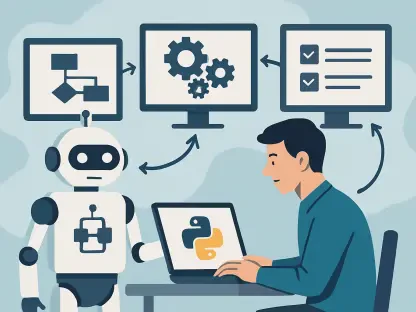Have you ever considered how often software projects miss the mark, failing to deliver what stakeholders envisioned, despite countless hours of coding and testing? Picture a major retail company launching an app, only to find that the checkout feature frustrates users due to a misunderstanding between developers and business teams. This scenario plays out far too often in today’s tech-driven landscape, where miscommunication can cost millions. Behavior-Driven Development (BDD) offers a transformative approach to align technical efforts with business goals, ensuring software meets user expectations from the outset.
The significance of BDD cannot be overstated in an era where technology underpins nearly every business operation. As companies race to innovate, the disconnect between those who build software and those who define its purpose often leads to delays, defects, and dissatisfaction. BDD tackles this challenge head-on by fostering collaboration across roles, using plain language to define software behavior. This guide delves into why this methodology is reshaping software development, offering insights from experts, practical steps for adoption, and real-world impacts that highlight its value.
Why BDD Is Crucial in Modern Software Development
In today’s fast-paced digital environment, the stakes for software projects are higher than ever. Businesses depend on applications to drive revenue, engage customers, and streamline operations, yet many initiatives falter due to misaligned priorities. Traditional development models often leave non-technical stakeholders sidelined, unable to fully grasp or influence technical decisions, resulting in products that miss critical objectives.
BDD stands out as a vital solution by prioritizing shared understanding over isolated workflows. It bridges the gap between developers, testers, and business representatives, ensuring everyone speaks the same language when defining what a system should do. A recent industry report noted that teams adopting BDD saw a 25% reduction in project delays, underscoring its role in delivering timely, relevant solutions that match market needs.
This methodology’s growing adoption across sectors like finance, healthcare, and e-commerce reflects its adaptability. By focusing on user-centric outcomes rather than just code completion, BDD helps organizations avoid the pitfalls of miscommunication. Its emphasis on collaboration positions it as an essential practice for any team aiming to create software that truly serves its intended purpose.
Core Principles and Advantages of Behavior-Driven Development
At its heart, BDD builds on Test-Driven Development by shifting the focus to user behavior, described in plain English through structured formats like “Given-When-Then.” This approach creates a common ground for technical and non-technical team members, using features to outline functionalities, scenarios to contextualize system responses, and steps to detail testable conditions. Such clarity ensures that every participant understands the expected outcomes before coding begins.
The benefits of this framework are substantial and multifaceted. Collaboration improves as stakeholders actively define requirements, while clarity reduces ambiguity in project goals. Enhanced test coverage catches issues early, and faster feedback loops accelerate iterations. A study from a prominent tech publication revealed that companies using BDD reported a 30% drop in post-release defects, thanks to proactive error identification during development.
Real-world applications further illustrate BDD’s impact. Consider a financial services firm developing a mobile banking app; by employing BDD, the team aligned intricate security features with user expectations through detailed scenarios, preventing costly revisions after launch. This precision not only saves resources but also builds trust in the software’s reliability, proving BDD’s worth in high-stakes environments.
Expert Perspectives on BDD’s Real-World Impact
Insights from those who have pioneered and practiced BDD shed light on its transformative potential. Dan North, who first introduced the concept, emphasized that it’s fundamentally about refining communication, stating, “BDD is a way to get the conversation right before the code is written.” This focus on dialogue over documentation resonates with teams striving for alignment in complex projects.
Practitioners echo this sentiment with tangible experiences. A lead developer from a tech startup shared, “Adopting BDD with tools like Cucumber turned chaotic requirement discussions into structured, actionable plans—our clients now see their vision reflected in every sprint.” Such feedback highlights how BDD fosters a sense of inclusion, making stakeholders active contributors rather than passive observers.
Industry recognition further validates these accounts. Surveys conducted among software teams indicate that over 60% of those using BDD report improved project transparency and stakeholder satisfaction. These voices collectively affirm that BDD isn’t just a methodology but a cultural shift, redefining how collaboration drives successful software outcomes in diverse settings.
A Step-by-Step Guide to Adopting BDD in Your Projects
For teams ready to integrate BDD, a structured approach ensures a smooth transition. Begin by engaging stakeholders to describe desired software behaviors in everyday language, focusing on user perspectives. This collaborative step lays the foundation for mutual understanding, capturing the essence of what the system must achieve in specific contexts.
Next, document these behaviors as features and scenarios using the “Given-When-Then” format, and select a supporting tool like Cucumber, Behave, or SpecFlow to automate testing. Set up the project environment—perhaps a Maven setup in an IDE like IntelliJ IDEA—and translate scenarios into executable step definitions using a language such as Java. Running these tests through a dedicated runner class allows for consistent validation of the system’s behavior.
Adherence to best practices amplifies success: involve stakeholders continuously, keep scenarios concise, avoid technical terminology, and refactor steps for efficiency. Starting with a single feature helps build familiarity before scaling up. This methodical roadmap transforms BDD from a theoretical concept into a practical strategy, aligning development efforts with business aspirations seamlessly.
Looking Ahead: The Lasting Influence of Behavior-Driven Development
Reflecting on the journey through BDD’s principles and applications, it becomes clear that this approach reshapes how teams tackle software challenges. Its ability to unite diverse roles under a shared vision stands out as a game-changer, turning potential conflicts into constructive conversations. The stories of reduced defects and enhanced clarity linger as proof of its effectiveness.
Beyond past achievements, the path forward invites teams to take actionable steps toward embracing BDD. Starting small with a focused feature, collaborating closely with stakeholders, and leveraging automation tools promises to build confidence in the process. These initial efforts pave the way for broader adoption, ensuring software consistently meets user needs.
As technology continues to evolve, BDD’s emphasis on communication offers a timeless framework for navigating complexity. Teams that commit to refining their dialogue and aligning their goals find themselves better equipped to handle future demands. This methodology, once a novel idea, emerges as a cornerstone for sustainable success in software development.









